Curry G.L., Feldman R.M. Manufacturing Systems Modeling and Analysis
Подождите немного. Документ загружается.


Problems 273
tribution Analysis Algorithm (Property 8.4) is more complicated and is best handled
in Excel with VBA as is the algorithm of Property 8.7. I n this appendix, we give the
Excel formula needed for the Mean Value Analysis Algorithm and leave the exten-
sions to the reader. The material in the Appendix of Chap. 3 can be used to find the
relative arrival rates (Property 8.1) of a network. Given the vector r, the following
can be used to obtain the cycle times for the network of Example 8.2.
The initial data of the problem is established by the following.
AB C DE
1 E[Ts-1] E[Ts-2] E[Ts-3]
2 0.2 0.5 0.5
3 r-1 r-2 r-3
4 110.9
We skip a row and then setup for the algorithm.
AB C D E
6 w CT-1 CT-2 CT-3 Sum
7 1 =B2 =C2 =D2
In Cell A8, type =A7+1 and then copy Cell A8 down through Cell A20. In Cell E7,
type
=SUMPRODUCT(B7:D7,$B$4:$D$4)
and copy Cell E7 down through Cell E20. Finally, the main iterative step is typed
into Cell B8 as
=B$2+B$2
*
$A7
*
B$4
*
B7/$E7
and then Cell B8 is copied to the right through Cell D8 and then B8 is copied down
through Cell D20. It is important when typing the various formulas that care is taken
to type the dollar signs ($) exactly as shown since at times the row indicator must
be an absolute address and sometimes the column indicator must be an absolute
address. The resulting spreadsheet should give the Mean Value Algorithm through
a CONWIP level of 14.
Problems
8.1. Find the relative flow rates for the network displayed in Fig. 8.4.
8.2. Find the relative flow rates for the network displayed in Fig. 8.6.
8.3. Re-consider the Example 8.2 and find the workstation and system performance
measures for a CONWIP level of
(a) 7 jobs, and
(b) 10 jobs.
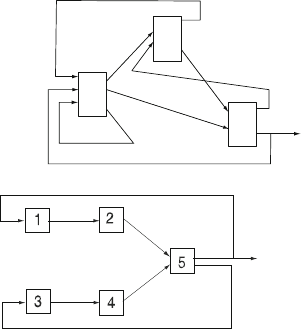
274 8 WIP Limiting Control Strategies
Fig. 8.4 Network flows for
Problem 8.1
1
2
3
4/6
1/6
1/6
1/2
1/2
1/4
3/4
Fig. 8.5 Network flows for
Problem 8.5
thru
good
bad
8.4. For the network of Problem 8.1, consider a CONWIP level of 5 jobs and as-
sume that each workstation has only one processor. The means of the exponentially
distributed service times at the three workstations are 15 minutes, 30 minutes, and
1 hour, respectively. Using the Mean Value Analysis Algorithm, find the expected
cycle time in each workstation, the expected work-in-process in each workstation,
the flow rate for each workstation, the total system throughput, and the system cycle
time.
8.5. Consider the following closed queueing network made up of single server work-
stations with routing structure displayed in Fig. 8.5. Consider that each workstation
has one machine with exponentially distributed processing times. Use the Mean
Value Analysis Algorithm with w
max
= 10 to find the expected cycle time in each
workstation, the expected work-in-process i n each workstation, the mean through-
put rate for each workstation, the total system throughput, and the system cycle time.
(a) Use the following data (based on an example in [4]):
E[T
s
]=(1/2,1/2,1,1,1)
Pr{good} = 1/2,
Pr{bad} = 1/2.
(b) Use the following data:
E[ T
s
]=(1/3, 1,3/2,1/2,2)
Pr{good} = 1/2,
Pr{bad} = 1/2.
(c) Use the following data:
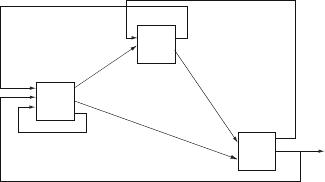
Problems 275
Fig. 8.6 Network flows for
Problems 8.2 and 8.6
1
2
3
6/8
1/8
1/8
1/4
3/4
4/5
1/5
E[ T
s
]=(1/3, 1,3/2,1/2,2)
Pr{good} = 3/4,
Pr{bad} = 1/4.
8.6. Consider the single product network model depicted in Fig. 8.6.
(a) Compute the relative flow rates (r
1
= 1, r
2
,r
3
).
(b) Let the mean processing times be given by (4 hr, 2 hr, 3 hr) for the three work-
stations and assume that there is only one processor at each workstation. The total
number of jobs kept in the system at all times is 10. Assuming that the cycle time
estimates for the three workstations converge to 32.769 hr, 3.335 hr, and 6.421 hr,
respectively, fill in the following information:
WIP
1
=?, WIP
2
=?, WIP
3
= 1.267
λ
1
=?,
λ
2
= 0.222,
λ
3
= 0.197
WIP
s
=?, th
s
=?, CT
s
=?
(c) Let Workstation 1 have two machines and re-compute the mean cycle time es-
timates for the three workstations as well as the mean throughput for the factory.
8.7. Consider the single product network model depicted in Fig. 8.7.
(a) Compute the relative flow rates (r
1
= 1, r
2
,r
3
).
(b) Let the mean processing times be given by (2.5 hr, 3 hr, 5 hr) for the three
workstations and assume that there is only one processor at each workstation. The
total number of jobs kept in the system at all times is 8. Assuming that the cycle time
estimates converge to (8.357 hr, 5.001 hr, 24.951 hr) for the three workstations, fill
in the following information:
WIP
1
=?, WIP
2
=?, WIP
3
= 4.563
λ
1
=?,
λ
2
= 0.152,
λ
3
= 0.183
WIP
s
=?, th
s
=?, CT
s
=?
(c) Let Workstations 2 and 3 have two machines and re-compute the mean cycle
time estimates for the three workstations as well as the mean throughput for the
factory.
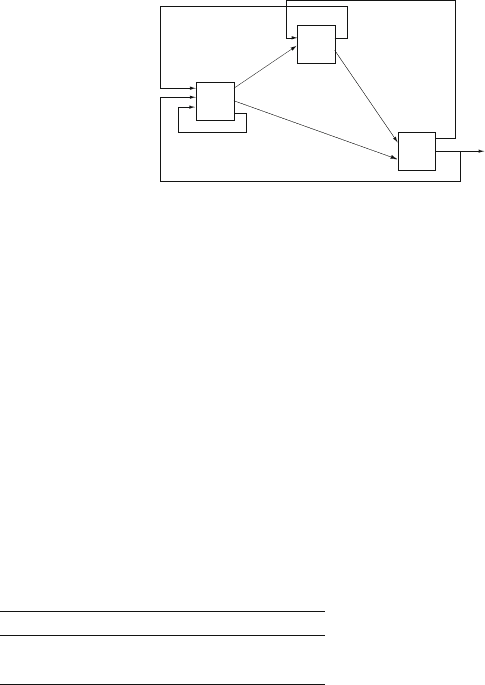
276 8 WIP Limiting Control Strategies
Fig. 8.7 Network flows for
Problem 8.7
1
2
3
1/3
1/3
1/3
1/2
1/2
3/4
1/4
8.8. Resolve Problem 8.4, with an additional processor at Workstation 2.
8.9. Resolve Problem 8.5 (a) with 1, 2, 1, 1, 2 servers in the respective workstations.
8.10. Resolve Problem 8.3 except assume that the SCV for all service times is 0.25
with a CONWIP limit of 5 jobs.
8.11. Solve Problem 8.4 except assume that the processing times at the workstations
have the following characteristics:
E[ T
s
]=(0.25,0.50,1.0) hr
C
2
s
=(0.75,1.25,2.0) .
8.12. Consider a two product production facility with three, single-server worksta-
tions. The WIP limits for the products are 2 and 3 jobs. Assume that the processing
times by product are exponentially distributed with mean times of
Product E[T
s
(i,1)] E[T
s
(i,2)] E[T
s
(i,3)]
i = 1 1.00 hr 2.00 hr 3.00 hr
i = 2 1.75 hr 2.50 hr 1.50 hr
The workstation transition probability matrices for the two products are:
P
1
=
⎡
⎣
1/53/51/5
1/51/53/5
2/52/51/5
⎤
⎦
and p
2
=
⎡
⎣
2/63/61/6
3/61/62/6
2/63/61/6
⎤
⎦
.
(a) Determine the cycle times and WIP’s by product and workstation using the al-
gorithm of Property 8.7.
(b) Compute the product and system performance measures given that the flow out
of Workstation 3 back to Workstation 1 is considered good production for both prod-
ucts.
8.13. Consider Example 8.5 with two products containing routes according to
Figs. 8.2a and 8.2b. Add a third product with its CONWIP level set at 7 jobs in
this facility. The mean processing times (in hours) for the third product in the three
workstations are E[T
s
(3,k)] = (0.6,0.4,0.5). The workstation transition probability
matrix for this product is
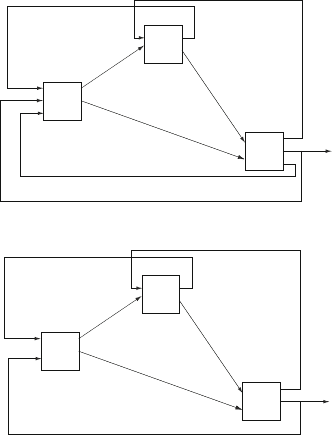
Problems 277
Fig. 8.8a Network flows for
Product 1 of Problem 8.15
1
2
3
2/3
1/3
1/2
1/2
8/10
1/10
rework
1/10
output
Fig. 8.8b Network flows for
Product 2 of Problem 8.15
1
2
3
1/2
1/2
1/3
2/3
3/4
1/4
output
P
3
=
⎡
⎣
02/31/3
4/501/5
3/41/40
⎤
⎦
.
Using the approximation algorithm of Property 8.8, determine the cycle times and
WIP levels for each workstation by job type. Assume that the flow from Worksta-
tion 3 to Workstation 1 is good production and determine factory mean throughput
and cycle time.
8.14. Reconsider the facility described in Problem 8.12 except let the WIP limits
for the products be 8 and 10 jobs, respectively. (a) Determine the cycle times and
WIP’s by product and workstation using the algorithm of Property 8.8.
(b) Compute the product and system performance measures given that the flow out
of Workstation 3 back to Workstation 1 is considered good production for both
products.
8.15. A two-product factory is operated by releasing units only when a job is com-
pleted. The company policy is to maintain exactly 8 units of Product 1 and 5 units
of Product 2 in the system at all times. So if a job of type i completes, another job
of that type is immediately released into the factory. The two products have quite
different processing sequences and times with routing structures as displayed in
Figs. 8.8a and 8.8b . All processing times are exponentially distributed. The mean
processing times by workstation and product are
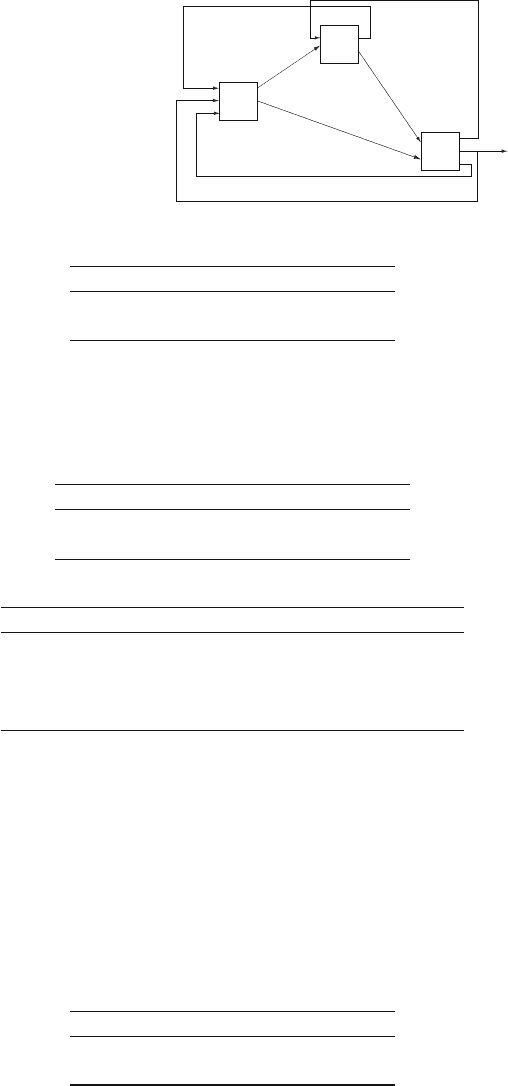
278 8 WIP Limiting Control Strategies
Fig. 8.9a Network flows for
Product 1 of Problem 8.16
1
2
3
2/3
1/3
1/2
1/2
8/10
1/10
rework
1/10
output
Product E[T
s
(i,1)] E[T
s
(i,2)] E[T
s
(i,3)]
i = 1 2.0 hr 3.0 hr 1.0 hr
i = 2 1.5 hr 2.0 hr 3.50 hr
Using the provided data, obtain the following answers using the algorithm of Prop-
erty 8.8.
(a) Find the relative arrival rates to the workstations.
(b) Write the equations for the workstation cycle times.
(c) Assume that the workstation cycle times are
WS 1 WS 2 WS 3
CT
1
k
8.543 hr 16.855 hr 8.086 hr
CT
2
k
8.275 hr 16.439 hr 9.681 hr
and complete the following tables.
WS 1 WS 2 WS 3
Product 1 WIP
1
k
2.566 3.730 1.704
λ
1
k
? 0.221/hr 0.211/hr
Product 2 WIP
2
k
? 2.036 1.598
λ
2
k
0.165/hr 0.124/hr 0.165/hr
(d) Give the workstation utilization factors.
(e) Give the system cycle times and throughputs f or the two products.
8.16. A two-product factory is operated by releasing units only when a job is com-
pleted. The company policy is to maintain exactly 6 units of each product type in the
system at all times. So if a job of type i completes, another job of that type is imme-
diately released into the factory. The two products have quite different processing
sequences and times with routing structures as displayed in Figs. 8.9a and 8.9b .
All processing times are exponentially distributed. The mean processing times by
workstation and product are
Product E[T
s
(i,1)] E[T
s
(i,2)] E[T
s
(i,3)]
i = 1 15min 30min 45min
i = 2 60min 42min 24min
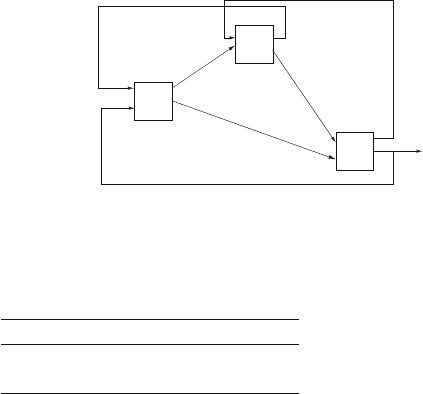
References 279
Fig. 8.9b Network flows for
Product 2 of Problem 8.16
1
2
3
1/2
1/2
1/3
2/3
3/4
1/4
output
Using the provided data, obtain the following answers.
(a) Verify the following relative arrival rates.
Product r
i,1
r
i,2
r
i,3
i = 1 1 0.737 0.702
i = 2 1 0.5 1.1111
(b) Using the algorithm of Property 8.7, determine the workstation cycle times if the
CONWIP levels were set to w
max
=(1,1).
(c) Using the algorithm of Property 8.8, determine the workstation cycle times and
workstation WIP levels by product for the CONWIP levels of w
max
=(6,6).
(d) Determine the workstation utilization factors.
(e) Determine the system performance measures.
8.17. Resolve Example 8.6 except assume that the service time distribution has a
Gamma distribution with shape parameter
α
= 2 (i.e., an Erlang-2 distribution) and
with mean values as specified by Table 8.9.
References
1. Askin, R.G., and Standridge, C.R. (1993). Modeling and Analysis of Manufacturing Systems.
John Wiley & Sons, New York.
2. Buzacott, J.A., and Shanthikumar, G.J. (1993). Stochastic Models of Manufacturing Systems.
Prentice Hall, Englewood Cliffs, N. Y.
3. Curry, G.L., Deuermeyer, B.L., and Feldman, R.M. (1989). Discrete Simulation: Fundamen-
tals and Microcomputer Support. Holden-Day, Inc., Oakland, CA.
4. Diagle, J.N. (1992). Queueing Theory for Telecommunications. Addison-Wesley Publishing
Co., Reading, Mass.
5. Duenyas, I. (1994). A Simple Release Policy for Networks of Queues with Controllable In-
puts, Operations Research, 42:1162–1171.
6. Gross, D., and Harris, C.M. (1998). Fundamentals of Queueing Theory, Third Edition, John
Wiley & Sons, New York.
7. Harrison, J.M., and Wein, L.M. (1990). Scheduling Networks of Queues: Heavy Traffic Anal-
ysis of a Two-Station Closed Network, Operations Research, 38:1052–1064.
8. Hopp, W.J., and Spearman M.L. (1996). Factory Physics: Foundations of Manufacturing
Management. Irwin, Chicago.
280 8 WIP Limiting Control Strategies
9. Marie, R.A. (1979). An Approximate Analytical Method for General Queueing Networks.
IEEE Transactions on Software Engineering, 5:530–538.
10. Marie, R.A. (1980). Calculating Equilibrium Probabilities for
λ
(n)/C
k
/1/N Queues. Perfor-
mance Evaluation Review, 9:117–125.
11. Reiser, M., and Lavenberg, S.S. (1980). Mean-Value Analysis of Closed Multichain Queuing
Networks. J. Association for Computing Machinery, 27:313–322.
12. Spearman, M.L., Woodruff, D.L., and Hopp, W.J. (1990). CONWIP: A Pull Alternative to
Kanban, International Journal of Production Research, 28:879–894.
13. Wein, L.M. (1990). Scheduling Networks of Queues: Heavy Traffic Analysis of a Two-Station
Closed Network with Controllable Inputs, Operations Research, 38:1065–1078.
14. Wein, L.M. (1992). Scheduling Networks of Queues: Heavy Traffic Analysis of a Multistation
Network with Controllable Inputs, Operations Research, 40:S312–S344.

Chapter 9
Serial Limited Buffer Models
Limited buffer capacity models can be used for the mathematical representations of
a form of kanban control. There are two aspects of limited buffer systems studied
in this chapter. First an approach for developing an analytical approximation model
for serial flow systems is developed. Then the issue of how these buffer values can
be set to yield an optimal system configuration is addressed.
The systems considered here consist of a set of workstations that have limits on
the number of work-in-process units allowed to wait at each of the single-server
processing stations. For serial systems, these workstations are connected in a serial
configuration so that jobs flow from the first to the second workstation only, and
then from the second to the third workstation, etc., until they exit the facility. Thus,
all jobs have the same routing sequence. The workstations have a set number of
jobs that are allowed into the workstation simultaneously and these limits need not
be identical. Let w
k
represent the work-in-process capacity limitation for Worksta-
tion k. This is the total number of jobs allowed in the workstation including the job
being processed. Only single-server machines in each workstation are considered;
the complexities of multiple servers in a limited-buffer capacity model is beyond the
scope of this analysis. (Thus, Workstation k will process jobs on Machine k so the
terms Workstation k and Machine k will be used interchangeably.)
There are several methods of operating a WIP-limiting control strategy. The ma-
jor policy is that a job may not proceed to the next workstation until a space becomes
available in that workstation. However, there are several ways the workstation can
operate. The concept of process blocking after job completion is generally used in
analytical models. That is, when a job is finished, it may not be removed from the
machine until space is available in the next workstation for this job. This effectively
blocks the machine from processing other jobs in its queue and is called blocking
after service. Another variation is blocking before service, that is the machine can-
not process the job until it has the authorization to move to the next workstation. A
control procedure frequently used in practice processes queued jobs in the worksta-
tion until they all have been processed and the machine is forced to be idle due to
the lack of unfinished inventory. In this chapter, only the blocking after processing
strategy is implemented for modeling purposes. This s trategy allows for the imme-
G.L. Curry, R.M. Feldman, Manufacturing Systems Modeling and Analysis, 2nd ed., 281
DOI 10.1007/978-3-642-16618-1
9,
c
Springer-Verlag Berlin Heidelberg 2011

282 9 Serial Limited Buffer Models
Fig. 9.1 Network structure
for the kanban analysis
0
1
2
3
B
BB
1
23
diate response of the system to congestion and does not delay the response until
several more jobs have been processed.
This chapter deals with a finite WIP control approach where the limits are placed
on the number of jobs allowed in each workstation rather than in the factory as
a whole as was done with the CONWI P approach of Chap. 8. The general ap-
proach is to develop approximate probability distributions for the number of jobs
in each workstation (somewhat) independently and then connect these to estimate
factory performance. To facilitate the individual workstation models, general pro-
cessing time distributions are approximated by easy to model exponential phases
while maintaining the first two moments of the general service distributions. By as-
suming that all distributions to be modeled have SCV’s greater than or equal to 1/2,
Coxian (GE
2
) process sub-models can be used and tractable steady-state queueing
models result. An approximation methodology is developed for serially connected
systems with finite buffers at each workstation. The methods of this chapter utilize a
decomposition approach that make the resulting models computationally tractable.
9.1 The Decomposition Approach Used for Kanban Systems
The system being modeled is a series of workstations, or machines, connected by
buffer spaces of varying capacities. Job releases into the facility are controlled by
an initial machine with an unlimited backlog that continuously processes jobs and
sends them into the first workstation as long as there is space for that job. When the
job cannot proceed into the first workstation, the capacity there being full, then this
“job release” machine is blocked using the same “blocked after processing rule” as
all “real” workstation machines. The pre-release jobs are not considered as actual
jobs and do not count as facility WIP. This initial process can be thought of as the
preparation time necessary for a job release. Figure 9.1 illustrates the serial network
structure being studied, where Machine 0 is a machine representing job releases
to the system and there is a buffer of finite capacity between each machine. It is
possible that job releases are simply due to an individual processing the order so
“machine” may be a misnomer, but it is used simply for ease of reference.
The system can be modeled by developing the steady-state equations defining
the proportion of the time that the system is in every possible state. This direct full
scale modeling approach gets into computational difficulty very quickly because the
number of states that have to be considered grows exponentially with the number
of serial workstations. For example, if there can be 5 jobs in each workstation and
there are 4 workstations in series, then each workstation would have states 0, ··· ,5,
and the total number of states necessary to model the network is 6
4
=1296; whereas
